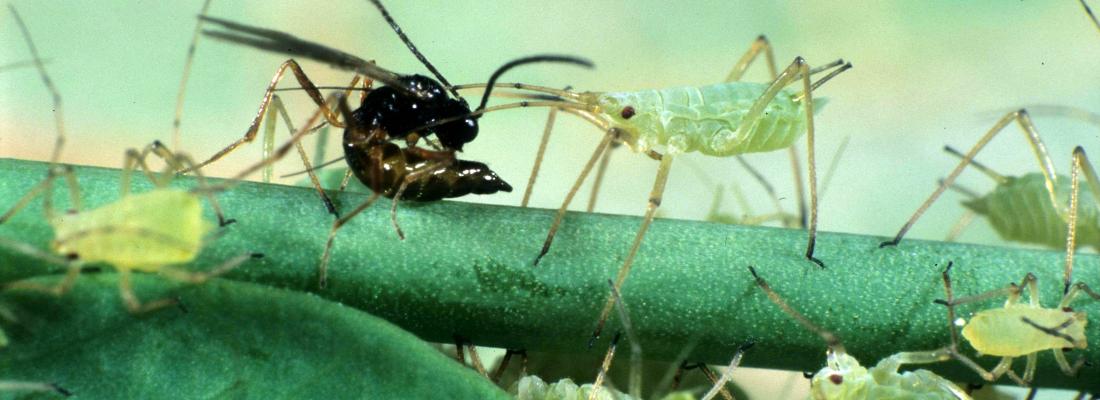Key-words : biocontrol, genome, wasps, biological control, parasitoid, aphids
As members of an international consortium, INRAE researchers took part in sequencing aphid parasitoid wasp genomes to gain a better understanding of the mechanisms these biological control agents use to take over their hosts. Genome annotation seems to point to immune system adaptations that allow the parasitoids to better resist aphid defenses and keep the aphids alive while the wasp develops in its host.
Published on 24 July 2020

Adapting in order to parasitize a host
Parasitoid insects are used in organic farming and integrated pest management to control crop pest populations and, in that way, limit the use of pesticides. Such insects lay their eggs in a wide range of agricultural pests including aphids, killing them in the process. Coevolution strategies govern the antagonistic relationships between parasitoids and their hosts, some of which are still poorly known and of interest to researchers.
In order to parasitize an aphid and develop within it, the wasp must adapt so as to counter the defenses of both the host and its protective endosymbionts. In collaboration with German, Chilean, Dutch, Italian and Swiss colleagues, INRAE scientists from the Institute of Genetics, Environment and Plant Protection; the Sophia Agrobiotech Institute; and the Institute of Ecology and Environmental Sciences studied the genome of two wasp species (Lysiphlebus fabarum and Aphidius ervi), which attack different aphid species, in order to understand which adaptations allow them to get around their hosts’ defenses.
Genetic adaptations to overcome a host’s defenses and take it over more easily
In the wasp species Aphidus ervi, researchers observed an expansion of some genes (FBox/LRR) that have an immunity-related function. This expansion may be related to the parasitoid’s ability to overcome its hosts’ defenses. In addition, while the two species whose genomes were sequenced do not infect the same aphid species, the protein content of their venom is quite similar, which could indicate that it is not involved in parasite specialisation. Finally, immune functions found in many insects were not found in the genomes of the two wasps, probably to allow them to maintain the host’s vital functions and, in that way, provide the required nutrients to the wasp larva at the aphid’s expense.
These findings are of fundamental interest for understanding the evolution of interactions between pest insects and their natural enemies and for developing biocontrol applications. They provide a sound basis for further functional studies of parasite/host coevolution.
Reference
Alice B. Dennis, Gabriel I. Ballesteros, Stéphanie Robin, Lukas Schrader, Jens Bast, Jan Berghöfer, Leo W. Beukeboom, Maya Belghazi, Anthony Bretaudeau, Jan Buellesbach, Elizabeth Cash, Dominique Colinet, Zoé Dumas, Mohammed Errbii, Patrizia Falabella, Jean-Luc Gatti, Elzemiek Geuverink, Joshua D. Gibson, Corinne Hertaeg, Stefanie Hartmann, Emmanuelle Jacquin-Joly, Mark Lammers, Blas I. Lavandero, Ina Lindenbaum, Lauriane Massardier-Galata, Camille Meslin, Nicolas Montagné, Nina Pak, Marylène Poirié, Rosanna Salvia, Chris R. Smith, Denis Tagu, Sophie Tares, Heiko Vogel, Tanja Schwander, Jean-Christophe Simon, Christian C. Figueroa, Christoph Vorburger, Fabrice Legeai & Jürgen Gadau Functional insights from the GC-poor genomes of two aphid parasitoids, Aphidius ervi and Lysiphlebus fabarum. BMC Genomics 21, 376 (2020). https://doi.org/10.1186/s12864-020-6764-0






